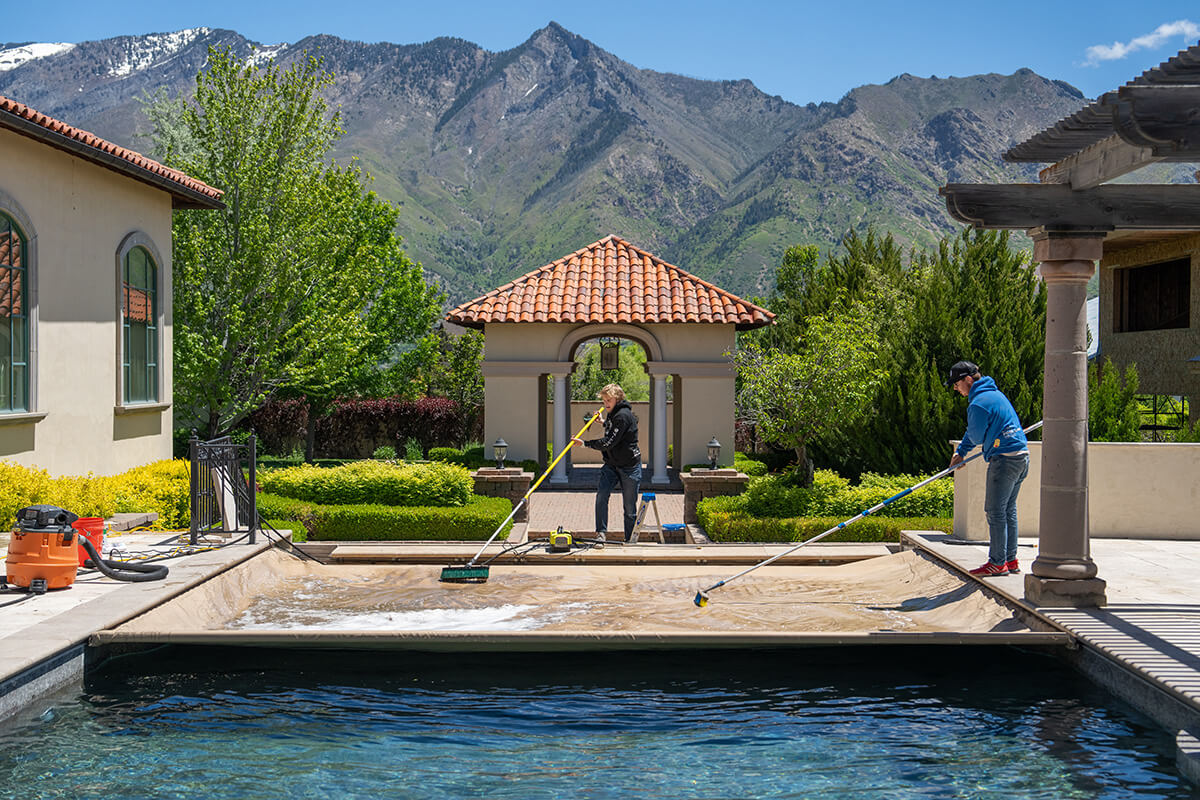Summer is here, and that means it’s time to make a splash in your pool! However, no one wants to take a dip in a dirty and murky pool. To fully enjoy your swimming oasis, regular pool maintenance is essential. In this blog post, we will explore various tried-and-true methods to clean your pool and keep it sparkling throughout the season. From skimming and brushing to vacuuming and chemical maintenance, we’ll cover everything you need to know to maintain a pristine pool environment. Get ready to dive into clean waters and create a refreshing oasis in your own backyard!
Methods To Clean Your Pool
1. Skimming:
Skimming the surface of your pool using a skimmer net attached to a telescopic pole is the first step in pool cleaning. Slowly move the net across the water’s surface, collecting leaves, debris, insects, and other visible contaminants. Start from one end of the pool and work your way to the other, emptying the net into a suitable container as needed.
2. Pool Brushing:
Brushing the walls, floor, and other surfaces of your pool helps remove algae, dirt, and grime buildup. Use a pool brush with appropriate bristles for your pool’s surface (concrete, fiberglass, vinyl, etc.). Start at one end and work your way around the pool, applying enough pressure to loosen debris but not so much that you damage the surface. Pay extra attention to areas around the waterline, corners, and steps. Brush in overlapping strokes for thorough cleaning.
3. Pool Vacuuming:
Pool vacuuming is essential for removing debris and dirt from the bottom of your pool. There are two main types: manual vacuums and automatic cleaners.
-
Manual Vacuums: Attach the vacuum head to a telescopic pole and connect it to the pool’s suction port or a dedicated vacuum line. Move the vacuum head slowly across the pool floor, overlapping each pass to ensure complete coverage. The vacuum will suck up debris into a collection bag or directly to the pool’s filter system, depending on the setup.
-
Automatic Cleaners: There are various types of automatic cleaners available, including suction-side, pressure-side, and robotic cleaners. Follow the manufacturer’s instructions for installation and operation. These cleaners move independently and collect debris into onboard filters or use the pool’s filtration system.
4. Pool Filter Maintenance:
-
Sand Filters: Backwashing is the primary method for cleaning sand filters. Start by turning off the pool pump and setting the filter valve to “Backwash.” Turn on the pump and let it run until the water in the sight glass becomes clear. Turn off the pump, set the valve to “Rinse,” and run the pump for about 30 seconds. Repeat the backwashing process until the water runs clear during the rinse cycle.
-
Cartridge Filters: Turn off the pump and remove the cartridges from the filter housing. Rinse the cartridges with a garden hose, ensuring all debris is removed. If they are heavily soiled, soak them in a cartridge cleaner solution as directed by the manufacturer. Once cleaned, reinstall the cartridges.
-
D.E. Filters: D.E. filters require periodic cleaning of the filter grids. Start by turning off the pump and releasing the pressure by opening the air relief valve. Remove the filter grids and thoroughly rinse them with a hose. If they are heavily soiled, soak them in a filter cleaner solution following the manufacturer’s instructions. Reassemble the grids and ensure proper alignment before reattaching them to the filter housing.
5. Water Testing and Chemical Maintenance:
-
Regularly test your pool water using a water testing kit to maintain proper water chemistry. Test the following parameters:
-
pH Level: Aim for a pH range of 7.4-7.6. Add pH increasers or decreasers as needed to achieve the desired level.
-
Total Alkalinity: Maintain total alkalinity between 80-120 ppm (parts per million). Adjust using alkalinity increasers or decreasers.
-
Calcium Hardness: The recommended calcium hardness level varies depending on the pool surface material. Generally, aim for a range of 150-250 ppm. Adjust using calcium hardness increasers or decreasers.
-
Chlorine Level: Ensure chlorine levels are within the recommended range for effective sanitization. Add chlorine or alternative sanitizers according to the test results.
6. Shocking and Superchlorination:
Regularly shock your pool to eliminate bacteria, algae, and other organic contaminants. Follow the manufacturer’s instructions for the specific shock treatment you are using. Typically, you’ll add the shock treatment directly to the pool water, distributing it evenly. Avoid swimming until the chlorine levels return to the recommended range.
7. Backwash Hose:
Backwashing is specific to sand filters. Attach a backwash hose to the waste port on the filter valve. When backwashing, water will be directed out of the pool and through the hose, carrying away debris and waste material. Always follow the manufacturer’s instructions for your specific filter model.
8. Pool Cover Cleaner:
If you have a pool cover, use a specialized cleaner designed for pool covers to remove dirt, debris, and stains. Follow the manufacturer’s instructions for the proper application and cleaning process.
9. Pool Tile Cleaner:
If your pool has tiles, a pool tile cleaner can help remove scale, mineral deposits, and other buildup from the tile surfaces. Use a soft brush or sponge and follow the cleaner’s instructions for application and scrubbing.
10. Water Leveling:
Monitor the water level in your pool and ensure it remains within the optimal range. Use a water leveling device or a garden hose to add water when needed. Avoid overfilling the pool; the water level should typically be at least halfway up the skimmer opening.
By following these methods and maintenance routines, you can ensure a clean and inviting pool for a refreshing and enjoyable swimming experience.
Conclusion:
In conclusion, maintaining a clean and pristine pool is within your reach by following these ten essential cleaning methods. By skimming the surface, brushing the walls, and vacuuming the floor, you’ll ensure that debris and dirt have no place in your swimming oasis. Regularly tending to your pool filter, testing and balancing water chemistry, and shocking the pool when needed will keep the water clear and sanitary. Don’t forget the importance of maintaining the water level, cleaning pool covers, and using specialized tile cleaners to add those finishing touches. By incorporating these ten methods into your pool cleaning routine, you’ll enjoy a sparkling and inviting pool all summer long, making it the go-to destination for relaxation and fun. So, roll up your sleeves and dive into the joy of a beautifully clean pool!


